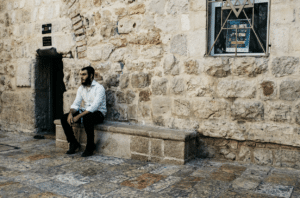Proposing to cut a baby in half is not everyone’s idea of excellent problem solving, but it sure put King Solomon on the map. The story of King Solomon’s wise judgement has gone down in history. What can we learn about creative problem solving in our lives and society from Israel’s wisest king?
Creativity in problem solving has been defined as “the processes that facilitate the generation of a solution that is both novel and appropriate”.1 Indeed, it is the novelty factor in both the approach and the solution that is the trademark of creative problem solving. Creative problem solving focuses on problems that are complex, ill-defined, and/or involve high levels of ambiguity.2 This certainly describes well the dilemma brought before the freshly crowned King Solomon.
High motivation and high stakes
As newly anointed king over the twelve tribes of Israel, having replaced his beloved and recently deceased father King David, Solomon would have been eager to establish his status as king. In fact, the previous two chapters record several of the obstacles Solomon encountered on his way to becoming king (the foremost being when his half-brother Adonijah prematurely declared himself king in 1 Kings 1:5-10). Solomon’s motivation to execute justice is further evidenced in his petition to the Lord for wisdom:
“Give your servant therefore an understanding mind to govern your people, that I may discern between good and evil, for who is able to govern this your great people?” (1 Kings 3:9).
It is significant that Solomon’s request for judicial wisdom immediately precedes the custody dispute, and the connection between the two accounts is emphasized by several contextual links within the narrative itself.4
There is a degree of cognitive restructuring that takes place within creative problem solving, which allows for contradictions and the removal of fixating influences.3 The cognitive aspect of problem solving is also evident in the numerous automatic processes that take place when trying to make sense of a problem, including the search for patterns and correlations with past experiences that begins the moment a problem is presented.
3 stages of creative problem solving
It has been suggested that creative problem solving tends to involve three key stages: (1) fact finding, (2) idea finding, and (3) solution finding.5 The account of Solomon’s judgment appears to follow this basic outline and includes elements of each of the three stages. Specifically, (1) the king listens, (2) cuts to the heart of the matter, and (3) justice is served.
The Biblical text invites the reader to participate in solving the problem by using a narrative strategy of revealing and concealing the identity of the true mother (Garsiel, 2002). The text has thus been included in its entirety, that the reader might enjoy the satisfaction of solving this unusual predicament alongside the renowned King Solomon.
1. Fact finding: The King Listens
Then two prostitutes came to the king and stood before him. The one woman said, “Oh, my lord, this woman and I live in the same house, and I gave birth to a child while she was in the house. Then on the third day after I gave birth, this woman also gave birth. And we were alone. There was no one else with us in the house; only we two were in the house. And this woman’s son died in the night, because she lay on him. And she arose at midnight and took my son from beside me, while your servant slept, and laid him at her breast, and laid her dead son at my breast. When I rose in the morning to nurse my child, behold, he was dead. But when I looked at him closely in the morning, behold, he was not the child that I had borne.” But the other woman said, “No, the living child is mine, and the dead child is yours.” The first said, “No, the dead child is yours, and the living child is mine.” Thus they spoke before the king. (1 Kings 3:16-22)
This first section of the text corresponds to the fact-finding stage in creative problem solving and provides the king (and the reader) with quite a bit of information, effectively paving the way to begin conceptualizing the problem.
The facts are these: there are two, unnamed women of questionable repute claiming maternal rights to a single living child. There is a dead child, an alleged coverup, and no witnesses. There has been significant trauma on both sides with the potential of additional future trauma.
The complicated, high-stakes nature of the situation is riddled with ambiguity and ripe for creative problem solving. In the narrative, the women are only referred to as “the one” and “the other,” creating the potential for further confusion between the mothers by the reader throughout the entirety of the text. Furthermore, Solomon is mentioned here only by his title of king (whereas earlier in the same chapter and in the following chapter he is referred to by name). This is reminiscent of his motivation to govern the people with justice, as previously discussed, and designed to emphasize his role as “the royal dispenser of justice”.6
In these verses, the king’s presence is noted twice: before the women present their cases (v. 16) and after the women finish speaking (v. 22). He listens without interjecting. It is noteworthy that Solomon gives the women opportunity to present their cases without interruption, particularly considering their low social standing. By quietly observing, reserving judgment, and allowing the women to present their cases unimpeded, he avoids potential biases that could hinder creativity and distort judgment.
Listening is an important tool for gathering facts to give Solomon a framework from which to determine the initial state in his creative problem solving process, which is necessary towards being able to identify the desired goal state (i.e., the solution) accurately and effectively. In the instance of Solomon’s judgment, the desired goal state appears to be twofold: 1) establishing immediate justice by returning the child to his rightful mother, and 2) establishing justice on a national level by positioning himself as a rightly discerning king, as previously discussed. The next section will bring the king (and the reader) one step closer to the solution.
2. Idea finding: Cutting to the Heart of the Matter
Then the king said, “The one says, ‘This is my son that is alive, and your son is dead’; and the other says, ‘No; but your son is dead, and my son is the living one.’” And the king said, “Bring me a sword.” So a sword was brought before the king. And the king said, “Divide the living child in two, and give half to the one and half to the other.” Then the woman whose son was alive said to the king, because her heart yearned for her son, “Oh, my lord, give her the living child, and by no means put him to death.” But the other said, “He shall be neither mine nor yours; divide him.” (1 Kings 3:23-26)
In this second section, the king speaks for the first time and paradoxically brings both clarity and confusion: Solomon briefly and objectively restates the problem (v. 23). Then, he is swift to get to the heart of the matter by proposing a single, ridiculous idea: divide the living child in two with a sword (v 25).
The contradictory nature of the king’s command to divide the living child in half required a massive tolerance of ambiguity, which is cognitively necessary when engaging in creative problem solving.
Moreover, this would have required significant self-distancing to reason wisely while withstanding the emotional scene that was certain to unfold. Solomon had no way of guaranteeing how the women would respond. If one of the women had fainted or hesitated in her response to the king’s outrageous idea, it is likely that the story would have taken a different turn. And, as research on the science of wisdom shows, the attribution of wisdom Solomon received depended on the situation’s outcome.7 Two dead children would not have been considered a satisfactory solution – and unlike the magician’s trick, there is no coming back from a body cut in two.
Nevertheless, the king’s unconventional idea in the form of a test effectively revealed the true mother and the underlying motives of the two women, without the shedding of blood (v. 26). Moreover, the reader has enjoyed the opportunity to experience the ah-ha moment firsthand when the true mother is revealed through the revealing and concealing literary style of the text. The true mother responds out of sacrificial love for the child’s wellbeing, while the other woman responds with malice. Beyond a biological connection, the true mother displays the genuine care of a parent, which is just as important when determining parental rights in a complicated custody case. This additional, previously missing piece of information enables the king to render his judgment.
3. Solution finding: Justice is served
The third and final stage of creative problem solving unsurprisingly entails finding a solution. This phase requires evaluation: was the solution useful? Did the solution satisfactorily bring about the desired goal state? In the case of Solomon’s judgment, the living child is returned to his rightful mother and Solomon’s reputation as a wise, just king is firmly established. The twofold goal state is achieved – justice prevails in the immediate situation and is established on a national level.
Then the king answered and said, “Give the living child to the first woman, and by no means put him to death; she is his mother.” And all Israel heard of the judgment that the king had rendered, and they stood in awe of the king, because they perceived that the wisdom of God was in him to do justice. (1 Kings 3:26-28)
Solomon’s dignified presence throughout the account in 1 Kings 3:16-28 is an example to those in position of influence in dealing with matters of societal justice. Living in the era of social media and immediate access to information on current events, I propose that we all have a level of influence and responsibility when it comes to issues of justice in our societies. And so, I would leave the reader, and myself, with a few thoughts for reflection:
- Do we earnestly desire justice, as Solomon did?
- Do we offer our presence, or do we withdraw from engaging in the sticky situations of social justice surrounding us?
- Do we respectfully give those who have been wronged the opportunity to speak, without jumping to conclusions, no matter their status in society?
- Do we seek creative solutions for the complex issues of justice in our lives and communities?
Solomon’s creative thinking cut through the noise and got straight to the heart of the matter. And in doing so, he leaves us a rich example of how creative problem solving can be used in the pursuit of justice.
- Harms, M., Reiter-Palmon, R., & Derrick, D. C. (2020). The role of information search in creative problem solving. Psychology of Aesthetics, Creativity, and the Arts, 14(3), p. 368
- ibid p.367- 380.
- Beda, Z., Smith, S. M., & Orr, J. (2020). Creativity on demand – hacking into creative problem solving. NeuroImage, 216, 116867-116867.
- Garsiel, M. (2002). Revealing and concealing as a narrative strategy in Solomon’s judgment (1 Kings 3:16-28). The Catholic Biblical Quarterly, 64(2), 229-247.
- Vernon, D., Hocking, I., & Tyler, T. C. (2016). An evidence-based review of creative problem solving tools: A Practitioner’s resource. Human Resource Development Review, 15(2), 230-259.
- Garsiel (2002) op. cit. p.235
- Grossmann, I., Weststrate, N. M., Ferrari, M., & Brienza, J. P. (2020). A common model is essential for a cumulative science of wisdom. Psychological Inquiry, 31(2), 185- 194.
Photo by Gigin Krishnan on Unsplash















